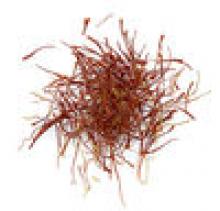I was given a tiny bit of saffron as a Christmas present, and I couldn't be more delighted. Although I have tasted saffron dishes before, I have never had the chance to cook with saffron myself. I can't wait, but I'm nervous about the possibility of ruining it by accident!
Saffron is the most expensive spice in the world. Up until fairly recently in human history, it could fairly have been called the most expensive thing in the world (by weight). Each thread of saffron is the stigma from a very specific kind of crocus, a domesticated variety which is not found in the wild.
Why is saffron so expensive? Each crocus puts out only three such stigmas per year. Each stigma must be hand picked, and hand cultivated. Every year, people must go out and pick the stigmas, then later dig up the crocus bulbs, divide them by hand, and re-plant them. This makes it a very labor intensive crop. According to Wikipedia, a pound of saffron represents the harvest from a saffron field the size of a football field.
Saffron was domesticated about 3,000 years ago, in Bronze Age Crete. However, wild saffron has been used by people as much as 50,000 years ago, where it was used as a pigment to create paintings of prehistoric animals. The Sumerians used saffron as a trade item, as did the ancient Persians around the 10th century BC.
The history of saffron is the history of human culture itself. Alexander the Great used saffron as a curative and antibacterial, using baths and poultices of the stuff to help cure his battle wounds. The Chinese emperor who wrote one of China's earliest medical text listed it as the cure to 252 different medical disorders. Cleopatra used it as an aphrodisiac. The Minoans documented its therapeutic usages in their frescoes. Saffron was used as a dye to provide yellow ink for medieval European illuminated manuscripts. During the Black Death, it was used to ward off the plague.
Today, saffron is most closely associated with the middle East (including Turkey, which is where my saffron was purchased as a gift). It is also associated with the native cuisine of Cornwall (the Romans brought it to the British Isles during their reign).
If you don't happen to have any saffron handy, turmeric makes an excellent (and affordable) substitution. Some dishes in which saffron is indispensible:
Saffron is the most expensive spice in the world. Up until fairly recently in human history, it could fairly have been called the most expensive thing in the world (by weight). Each thread of saffron is the stigma from a very specific kind of crocus, a domesticated variety which is not found in the wild.
Why is saffron so expensive? Each crocus puts out only three such stigmas per year. Each stigma must be hand picked, and hand cultivated. Every year, people must go out and pick the stigmas, then later dig up the crocus bulbs, divide them by hand, and re-plant them. This makes it a very labor intensive crop. According to Wikipedia, a pound of saffron represents the harvest from a saffron field the size of a football field.
Saffron was domesticated about 3,000 years ago, in Bronze Age Crete. However, wild saffron has been used by people as much as 50,000 years ago, where it was used as a pigment to create paintings of prehistoric animals. The Sumerians used saffron as a trade item, as did the ancient Persians around the 10th century BC.
The history of saffron is the history of human culture itself. Alexander the Great used saffron as a curative and antibacterial, using baths and poultices of the stuff to help cure his battle wounds. The Chinese emperor who wrote one of China's earliest medical text listed it as the cure to 252 different medical disorders. Cleopatra used it as an aphrodisiac. The Minoans documented its therapeutic usages in their frescoes. Saffron was used as a dye to provide yellow ink for medieval European illuminated manuscripts. During the Black Death, it was used to ward off the plague.
Today, saffron is most closely associated with the middle East (including Turkey, which is where my saffron was purchased as a gift). It is also associated with the native cuisine of Cornwall (the Romans brought it to the British Isles during their reign).
If you don't happen to have any saffron handy, turmeric makes an excellent (and affordable) substitution. Some dishes in which saffron is indispensible:
- Spain: Paella, a kind of casserole with rice as a base, and a variety of delicious pan-seared meats and vegetables mixed in.
- Italy: Risotto alla Milanese, the unofficial dish of Milan.
- France: The classic bouillabaisse. Traditional bouillabaisse is a slowly simmered fish stew that uses cheap bony fish like rockfish, and classic Provencal herbs and spices like garlic and basil.
- Morocco: Tajine dishes, which pair slowly simmered meats with a saffron infused sauce, such as this recipe for Lamb Tagine.
- India: Saffron is important in many Indian dishes, most importantly the biryani, which is another casserole-like rice dish.
